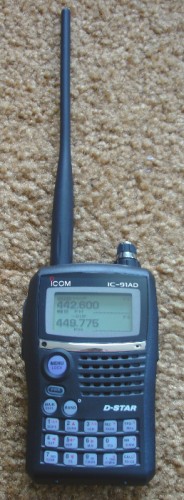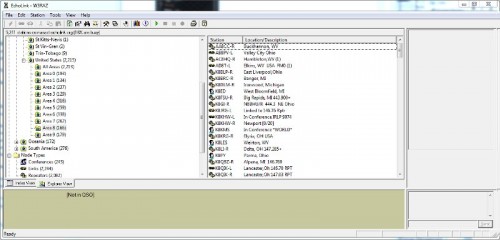In my second post on Amateur Radio, I talked about getting a 2 meter/70 centimeter handheld radio as your first radio. The main reason I suggested those kinds of radio as the first radio to buy is that you will likely need it for local public service. A dual band radio relatively inexpensive and is pretty forgiving when compared to other radios. When you make a mistake on the air, it will likely only be you and your local group of hams that will hear your error. That is not necessarily the case with HF or High Frequency Radio.
HF Radio, or High Frequency radio is likely the radio you think of when you first think about Amateur Radio. They usually are bigger than the 2 meter gear you might first buy and they are much more pricey if you are looking at new gear. HF Radios can also be called world-wide radios as with as little as a few watts of power you could talk to the world.
HF has Many Modes and Bands
Most HF rigs have many bands. HF radios typically will start at the 10 meter band and go down to the 80 or 160 meter bands. I say go down as the 160 meter band has a much lower frequency than the 10 meter band. 10 meters starts around 28 MHz. The lowest band, 160 m goes as low as 1.7 MHz. So what is this 10m, 20m, 160m stuff about then and why does this number go up as the frequency goes down? Well, when you hear a ham refer to a band as a X band (with X being a number from 2 to 160) they are referring to the wavelength of the signal. The wavelength is the distance from one peak of the signal to the next peak. As the frequency goes down, the distance between the peaks goes up. So that is why we refer to a band as a length measurement sometimes rather than just the frequency. Having more than one band also let’s you communicate more often as only some of the bands will be usable at any given time.
As for modes, you can run what amateur radio operators call phone or voice, CW (which is Morse Code) or one of the many digital modes. Some of these modes require additional equipment like a set of paddles and a keyer for CW or a sound card interface for some digital modes.
So what are these modes all about?
CW(Continuous Wave) or Morse code is the first mode that was ever used on amateur radio and it came from the era of the telegraph. With morse code, you can use what hams call a straight key to transmit dots (or dits as hams would say) and dashes (or dahs) in certain sequences to form letters and ultimately words. The straight key is the older way of doing CW. Modern hams usually use a keyer and a set of paddles. Press one side and you get a string of dits or dots. Press the other side and you get dahs or dashes. It used to be a requirement to be able to receive Morse Code to get a license for the HF bands, but it’s no longer a requirement anywhere in the world and is seen by many as an obsolete mode. However, Morse is still massively popular and is commonly used. Many repeaters transmit their repeater ID’s in Morse as it can be easily heard over voice so the repeater can meet their identification requirement of every 10 minutes even when other stations are using the repeater. CW can also be received and transmitted by computers now, but most hams I know still use their ear to receive morse code and a set of paddles for transmitting.
Phone, or voice is similar to what you might have done using a CB or Family Radio Service radio. You pick up a microphone and press a button to talk. Phone itself can be in many different modulation formats. Single Side Band is the most popular as its narrow bandwidth will let more stations use the same band. Single Side Band also usually sounds weird if you’ve never heard it before. This is especially the case if the receiver is slightly off frequency. AM or Amplitude Modulation sounds more like you might be used to when listening to the common AM broadcast band in your car and the same with FM or Frequency Modulation. HF Radios usually use Single Side Band (or SSB) or AM but you can also find FM on the 10m band.
Digital modes are not as standardized as the phone or CW modes and are usually based of one of the phone modes. Common modes used when using digital on an HF radio are PSK31, PACTOR, GTOR and many others. These are closely related to the old teletype systems.
HF Radio is Fun and Challenging, but There ARE Other Ways
If I were to cover every nuance of HF Radio operation, this article would be HUGE. So this is just a starting point. HF bands are the prime bands where world-wide communications is possible with a somewhat modest station. It’s a challenge to operate an HF radio station because there are so many things that can go wrong. Solar conditions, the time of day and many other variables can literally shutdown communications on some HF bands. However, when conditions are right it is possible to talk to someone in pretty much any country on the planet.
It’s ALSO possible to communicate to people in other countries with something a bit less expensive. Two ways I will briefly describe are Echolink and D-STAR.
D-STAR
D-star is a relatively new mode that’s seeing increased use primarily on the VHF and UHF amateur bands. D-STAR is an acronym that stands for: Digital Smart Technologies for Amateur Radio. D-STAR is, essentially, a digital voice mode that is based on FM. It’s very much like Skype in that it has a very high audio quality and has the ability to send messages and other data on the same signal simultaneously. D-STAR stations usually transmit their ID every time they key up. Also, if your radio has a GPS, you can ALSO transmit your current location. D-STAR is primarily a mode used on repeaters but by adding a high-speed Internet connection and a gateway at the repeater site, it’s possible to connect to other repeaters just utilizing your handheld. You can also connect to D-STAR repeaters directly over the Internet using a special USB dongle that you plugin to your computer.
The biggest problem with D-STAR is that it uses a proprietary codec. This codec goes by the name AMBE which stands for Advanced Multiband Excitation. Since its proprietary, it drives up the costs of the radios and limits who makes them. Currently, Icom is the only company that makes radios that can operate on D-STAR.
Also, there are those in the amateur radio community who would say that using D-STAR to talk to Italy doesn’t count as Amateur Radio. I don’t agree with that concept, but I ALSO don’t think that you should be able to use this to count towards awards like the Worked All States award (an award you can earn if you have contacted someone in all 50 states) or the DXCC Award (same as Worked all States except that you have to contact 100 different countries) and the current rules for these awards disallow the use of the mode for the award.
EchoLink
EchoLink is a mode where you can talk to other stations anywhere by using just your computer or a radio talking to a repeater with an operator connected to the repeater. EchoLink uses software that runs on Windows and Mac’s primarily to connect to repeaters on the EchoLink network. Again, it’s very much like Skype with the exception that there’s usually a repeater on the other end allowing you to communicate with handheld and mobile hams in another country. It also cannot be counted towards awards, but it’s yet another way you can use your amateur radio privileges to talk to anyone in the world.
Why use Amateur Radio over Skype, E-mail or other Internet Technologies?
Why? Because it’s fun! It encourages the continued use of science and math since you need to know the science and math of radio to use it. As an amateur radio operator, I am always looking for new things to get into and to learn how to operate new modes. Making antennas from different things and sometimes even fixing my own radios are much more challenging than just buying a new device. Plus, it thrills me to make contact with a station that’s far away from me using only my radio, a simple antenna that costs well under 100, and my ears. It’s the thrill of the chase when your hunting down contacts that keeps me interested.
I hope you find this post interesting and that it helps convince you of the value of being a ham as well as how fun it can be. If you’re looking for a more challenging way to talk to people all across the globe, then Amateur Radio is for you!




